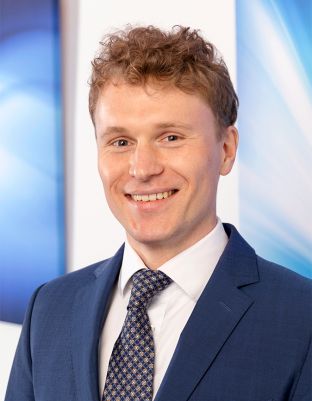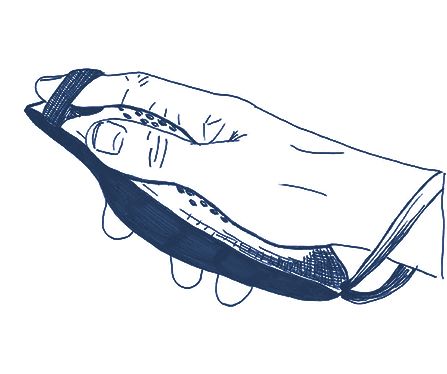
In season 10, episode 1, of the TV show "Die Höhle der Löwen" (German version of the US show Shark Tank and the UK show Dragon's Den), a sports physician presents a product specifically for runners that straightens the upper body and puts it in an optimized posture: the Laufmaus (German for "running mouse").
The product is a plastic molded part that is worn in the palm of the hand during sports and is supposed to trigger reflexes there to improve the posture of the body and ultimately also the running movement.
The patent granted for the Laufmaus can be regarded as exemplary for a basic patent with a relatively broad scope of protection. In the case of competitors, a broad scope of protection can ensure a monopoly position.
The following explains why the scope of protection did not have to be restricted in the examination proceedings and what a suitable strategy for building up a patent portfolio for the product could have looked like. After all, the value of a company grows with the patent portfolio, which should therefore have a high priority in every company.
The product: Laufmaus. What is it about?
The Laufmaus consists of a plastic molded part that can be worn in the palm of the hand. An index finger loop and a wrist loop are provided for fixation. To aid in lightweight design and sweat removal, the Laufmaus has a large number of holes over the entire surface thereof. The Laufmaus is shaped to fit specifically to the palm and fingers of the hand.
The patent application (Ref.: 10 2017 112 923.5).
Originally, an attempt was made to protect the Laufmaus as a hand grip element in a PCT application. Claim 1, which basically determines the scope of protection for the product (see Figs. 1 and 2 below; the numbers in brackets are for illustration) defines:
A handgrip element (1) having an elongated hand grip body (2) with a first end region (3) and, arranged at a distance thereto in the longitudinal direction of the hand grip body (2) a second end region (4), wherein the hand grip body (2) has a first shaped surface (5) located adjacent to the second end region (4), with a curved subregion for supporting a subregion of the ball of the human hand, and an outwardly curved second shaped surface (7) located adjacent to the first shaped surface (5) for supporting a subregion of the palm (8), and an inwardly curved third shaped surface (9) adjacent to the first shaped surface (5) for supporting the substantially extended thumb (17), and an outwardly curved fourth shaped surface (14) lying substantially opposite the third shaped surface (9) for supporting the middle finger (11), adjacent to which fourth shaped surface (14) an outwardly curved fifth shaped surface (16) is provided for supporting the ring finger (12), and the hand grip body (2) has a sixth shaped surface (10) provided to support the index finger (18), wherein the sixth shaped surface (10), starting from a subregion (23) of the second shaped surface (7) spaced apart from the second end region (4) of the hand grip body (2), extends toward the first end region (3) and runs substantially in the longitudinal direction of the hand grip body (2).
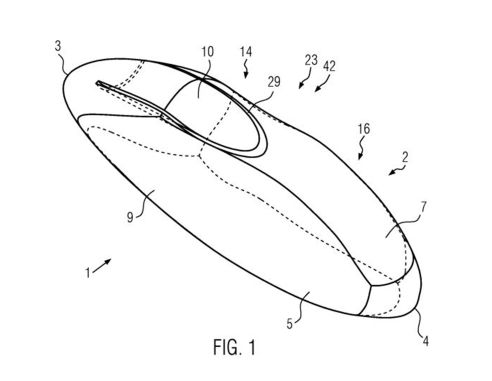
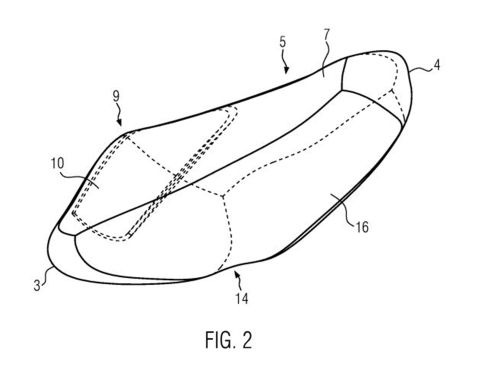
Examination proceedings
In the examination proceedings before the German Patent and Trademark Office (GPTO), the examiner cited document D1 (EP 2 168 641 B1) and D2 (US 8,092,411 B2) as prior art for claim 1, which is decisive for the scope of protection of patents.
D1 discloses, as can be seen in Fig. 1 of D1 shown below on the left, a grip 1 for a pole (not shown). In particular, this grip is to be used for walking or hiking (see claim 1 of D1).
D2 discloses, as can also be seen in Fig. 6 of D2 shown below on the right, a hand orthosis 10'. A
user grips the hand orthosis 10' with their hand which is then bandaged in this gripping position.
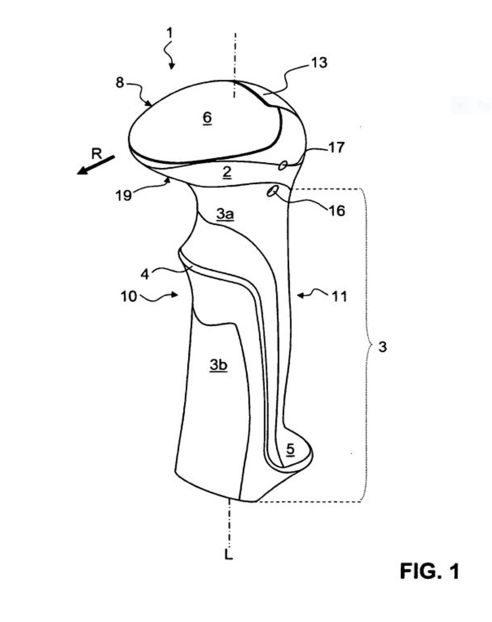
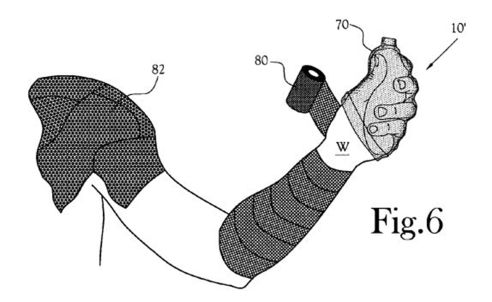
The examiner states in the examination proceedings that the invention is distinguished from the prior art by the part of claim 1 underlined above. However, the examiner does not immediately recognize an inventive step of the subject-matter of claim 1 over D1 and D2.
Further, in the examination proceedings, the examiner raises the objection of clarity of the claims and states that the reference signs (8), (11), (12), (17) and (18) do not refer to the subject-matter of the invention (handgrip element) but to parts of the human hand. According to the examiner, it was questionable whether this made the claim sufficiently clear.
Info: Clarity is one of the requirements for obtaining a patent grant in proceedings before the European Patent Office. In examination proceedings before the GPTO, lack of clarity is not a ground for rejection, but this objection is nevertheless frequently raised by German examiners. The reason for this is usually that claims tend to be drafted concisely and abstractly in order to secure the broadest possible scope of protection. Ultimately, however, suitable clarifications that are not unnecessarily restrictive can almost always be found and introduced into the claims during the proceedings.
As a result of the two objections mentioned above, the applicant decided to amend claim 1 merely by deleting these allegedly unclear reference signs. Thus, the human parts not belonging to the handgrip element (fingers, palms, etc.) are not part of the ultimate patent claim.
Info: Reference signs in the claims do not have a restrictive, but merely an explanatory meaning.
The scope of protection therefore remains unchanged by this amendment.
Compared to the prior art, the subject-matter of claim 1 is distinguished by "a sixth shaped surface (10) provided to support the index finger (18)" which "runs substantially in the longitudinal direction of the hand grip body (2)". The alignment of the index finger relative to the thumb has the technical effect of straightening and stabilizing the body posture when walking/standing. In contrast, D1 (cf. Fig. 1 of D1) as well as D2 (cf. Fig. 6 of D2) describe an opposing position of thumb and index finger. Thus, a different technical effect is achieved in D1 and D2 than is in the present case.
Based on the amended claim 1 and this reasoning, a patent (DE 10 2017 112 923 B3) was subsequently granted.
Patent portfolio
An original invention idea is protected by a basic patent. Based on this, a product is usually further developed. These further developments can be referred to as new invention ideas that are dependent on the original one.
Such further developments are often independently patentable and should therefore be protected by further patents in the interest of the applicant. If this is not done, it may happen that third parties (competitors, for example from abroad) come up with the idea of further developing the product themselves and are granted a patent for these further developments (dependent patents).
In the worst case, the actual inventor or the patentee of the basic patent can no longer bring the further developments onto the market because a competitor has obtained their own property rights for them. Thus, the patentee of the basic patent would have to acquire a license from this competitor in order to be able to market the further developed product. However, the same also applies in the other direction, namely that the patentee of the basic patent can prevent the competitor's further developed products from entering the market with their basic patent.
The Laufmaus available on the market has undergone significant development since the patent application was filed. A common procedure in such a case is to file so-called dependent patents in order to expand one's own patent portfolio.
Info: A dependent patent falls within the scope of protection of the temporally older patent and specifies further important features, e.g. of a product. Dependent patents arise when a basic idea is continuously developed. Thus, further patents can be granted for additional ideas based on the basic idea, even though the basic idea itself is already protected.
If one compares the product of the Laufmaus presented in the TV show with the patent application, it is apparent that some essential features are recognizably present, but not specified in the patent application. For example:
• Through holes at least on the second surface (7);
• Voronoi structure of the through holes;
• Irregularly arranged through holes;
• (Half) shell shape of the hand grip element (1);
• Finger loop for index finger with hook-and-loop fastener (Velcro closure); or
• hand grip element (1) manufactured in one piece.
Recommendation for an extended patent portfolio
The decisive factor in pursuing patent applications is the underlying strategy. The basis for this should always be the applicant's business interests, in particular which markets (regional, national, etc.) are to be addressed.
Info: For each applicant, it is important to weigh up which markets will be of interest for the respective product in the future (> 5 - 10 years) and to secure these markets through patent applications.
Since the above examples of further developments are already publicly known, a subsequent, further patent application directed to these further developments is no longer possible - the same goes for competitors. The examples are merely intended to illustrate what an extended patent portfolio strategy might look like.
In order to avoid the case of dependent patents owned by competitors, the patent portfolio should be constantly expanded and an attempt should be made to obtain a patent for the necessary and advantageous further developments. Only in this way the patentee of the basic patent can prevent competitors from entering or expanding the market and secure their time advantage in future developments.
Conclusion
The success of a product thus also lies in the development of a strong patent portfolio if potential future competitors are to be driven out of the market. When designing a patent portfolio, further developments should also be patented even before they are announced to the public in order to protect not only the basic idea but also the technical further developments and to prevent dependence on competitors' patents. The example of the Laufmaus was used to highlight a number of features with which it would have been possible to obtain a broader patent portfolio. Patent applications directed to these features are now no longer possible because they are already publicly known. Consequently, the potential to protect the Laufmaus does not seem to have been fully exploited. At this point, it should also be noted that patent applications are not published until after 18 months and, at the time of writing, no further patent applications relating to the Laufmaus were known to the public.
Author: Julian Graf
German and European Patent Attorney
Disclaimer: The above contribution reflects the personal opinion of the author. The assessments and statements made in the article do not constitute legal advice and are provided under exclusion of any liability. If you need an assessment of an individual case, please contact the author and/or the law firm KUHNEN & WACKER.


